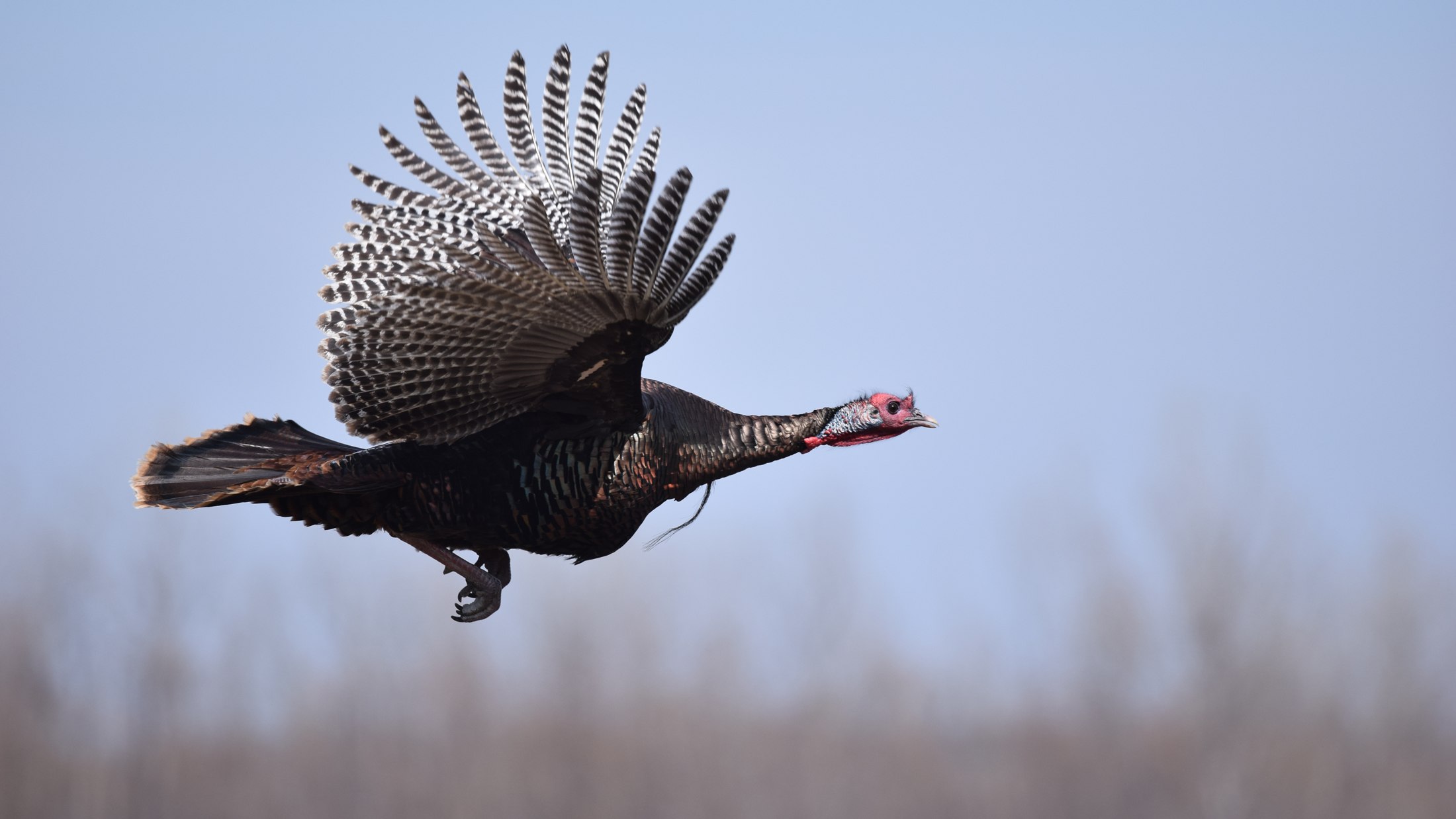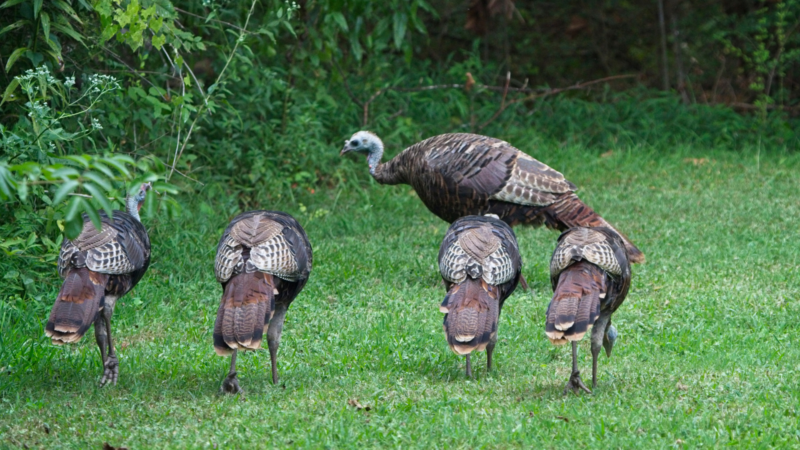It’s fun to see wild turkeys strutting through backyards and neighborhoods. But can wild turkeys fly? And if they can, how fast are they? Depending on what you’ve heard, the answers might surprise you.
Turkeys are a familiar sight during the fall season, as we prepare our Thanksgiving feasts. But one question has long perplexed those who observe these large awkward birds strutting through yards or across roads – can turkeys fly?
The short answer is yes, turkeys can fly However, there are some important caveats Wild turkeys are capable of flight, while domesticated turkeys raised on farms are often too heavy to get airborne. Even wild turkeys don’t fly particularly high or for long distances. Their flights are typically limited to quick bursts designed to get them over obstacles or up into trees.
Wild Turkeys: Built for Brief Flights
Wild turkeys evolved the ability to fly as a survival adaptation. Though they spend most of their time on the ground, wild turkeys are able to fly to escape predators, reach food sources, or get to safe roosting spots for the night.
A wild turkey’s body is well-suited for brief bouts of fast flight Their wingspan ranges from 4 to 5 feet, providing enough surface area to generate lift with rapid flapping Their breast muscles also contain an abundance of fast-twitch muscle fibers, allowing them to achieve great power and speed.
When wild turkeys take flight, they are capable of reaching speeds upwards of 55 miles per hour. This allows them to quickly escape danger or traverse short distances between trees or over fences. However, their flights do not sustain for more than a quarter mile or so before the birds must rest and recover.
You’re unlikely to ever see wild turkeys engaging in long, sustained flights. Instead, look for them making quick hops up to tree branches, flying across roads, or startlingly bursting into flight when alarmed.
Domestic Turkeys: Grounded by Human Breeding
On the other hand, the domesticated turkeys raised on farms for their meat are a completely different story when it comes to flight capabilities. Selective breeding by humans has rendered these birds unable to fly at all.
Domestic turkeys have been bred specifically for meat production, with large breast muscles being the most desirable trait. This extreme breast muscle mass makes it impossible for their wings to lift their heavy bodies off the ground.
Other factors also limit domestic turkeys’ flight abilities. Their wings are often clipped to prevent any accidental flights. They also lack the motivation to fly since food and shelter is provided to them and they face no predators.
So while their wild cousins take readily to the air, domestic turkeys are completely earthbound. Any flights a domestic turkey may achieve will be clumsy, short hops at best.
Why the Confusion Over Turkey Flight?
Given these very different realities for wild and domestic turkeys, it’s no wonder that the question “can turkeys fly?” has long perplexed observers. Most of us are only familiar with the docile, obese domestic turkeys that could never manage to fly up and roost in a tree. Watching a plump farm turkey barely manage to shuffle along, flight seems absurd.
Our lack of experience seeing wild turkeys in action also contributes to the misconception. Wild turkeys don’t migrate and spend most of their time on the ground foraging. When they do take to the air it happens quickly, so it’s easy to miss. People may wrongly assume that since we rarely see turkeys flying, they must be incapable of it.
But as backyard wildlife watchers and biologists can confirm, wild turkeys are entirely capable of flying short distances. Next time you spot a turkey, look closely and you may catch it making an impressive vertical leap or flying across your line of sight! Just don’t expect its domestic cousin to join in.
Amazing Facts About Wild Turkey Flight
Now that we’ve settled the question of whether or not turkeys can fly, here are some additional amazing facts about wild turkey flight capabilities:
-
Wild turkeys can reach speeds of 55 mph while flying. That rivals many birds we commonly associate with speed and agility!
-
Their burst flight abilities give them a degree of maneuverability that’s unexpected from such a large, heavy bird. They are able to quickly dodge obstacles.
-
Wild turkeys have excellent vision that helps them navigate obstacles during flight. They see in full color with 3X better acuity than human eyes.
-
Young turkeys begin developing flight capabilities at just 2 weeks old, starting with short practice hops.
-
Turkeys sleep in trees at night and fly up to their roosts around sunset each evening. In the morning they’ll fly back down at sunrise to begin foraging.
-
Males are faster fliers than females due to their larger wingspan relative to their body size. However, males rarely fly because of their cumbersome tail feathers.
-
Turkey flight is usually initiated as an escape strategy from perceived threats. Loud noises, predators, or disturbances can cause them to take sudden flight.
So while backyard turkeys may seem ungainly as they wander slowly about, remember that they are capable of becoming graceful, efficient fliers when they need to be!

So, can turkeys fly?
Yes, wild turkeys can fly short distances at surprisingly fast speeds up to 60 miles per hour. They will often fly up into trees to roost at night, keeping them safe from predators. But it’s rare to see turkeys fly. Plus, domesticated turkeys (those raised to live on farms) don’t always fly. So it’s easy to see why there is often a lot of debate around this topic. Check out some flying turkeys in this video, along with some additional wild turkey facts.
Now that you know wild turkeys can fly, you might be interested to know a little bit more of the science behind it. We spoke with bird expert Laura Erickson, who is a scientist, writer, and former middle school teacher. She’s loved birds since she was a little girl and has been writing and talking about them for many years. This includes everything from her For the Birds radio show to her most recent award-winning book 100 Plants To Feed the Birds.
To help us better understand turkeys and their flight, we asked her to break it down for us. You are sure to learn a thing or two about turkeys. Keep reading!
Why do so many people think turkeys can’t fly?

“Turkeys spend so much time on the ground eating and socializing with other turkeys that people think of them as ground birds,” Erickson says. “And many people are more familiar with farm turkeys than with wild ones. Although they belong to the exact same species, farm turkeys have been bred for many, many generations to have heavy pectoral muscles—the muscles that power the wings.”
Erickson says those larger pectoral muscles make it too heavy for their wings to support. Every once in a while, some farm turkeys can fly, but most cannot.
Can Turkeys Fly?
FAQ
How high can turkey fly?
Is turkey a flightless bird?
How fast can a turkey run and fly?
Can wild turkeys fly?
Yes. Wild turkeys can fly. They forage on the ground, but at night, they will fly to the top of trees to roost. This helps protect them from predators lurking around at night. Not only will they fly up into trees, but they will also fly away from a scare or predator nipping at their heels.
Why do turkeys have to fly?
The wild birds have to fly because they often roost in tall trees at night. It’s not clear exactly where the myth turkeys can’t fly originated. However, these birds tend to spend most of their time on the ground.
How high do wild turkeys fly?
Wild turkeys usually fly low to the ground. Their typical flight takes them high enough to reach branches of trees. They favor picking branches around 6 to 9 meters in height, but they can go as high as 15 meters if needed. These altitudes provide them with a vantage point to spot potential dangers and offer protection from many ground predators.
How fast can a wild turkey fly?
Once airborne, a wild turkey will quickly reach its intended roosting spot, or land on the ground a safe distance from the threat that spooked it into flight. On land, wild turkeys can cover far more ground, reaching running speeds of around 40 km/h (25 mph).
